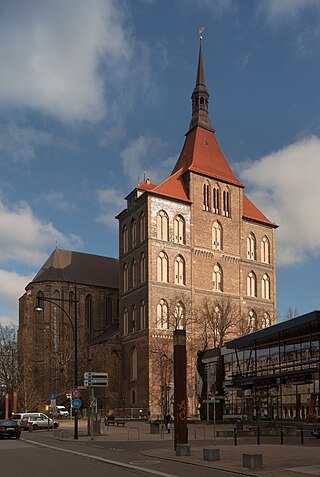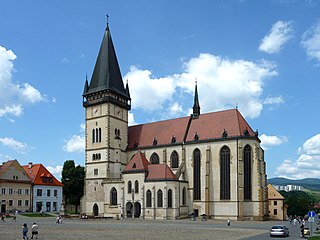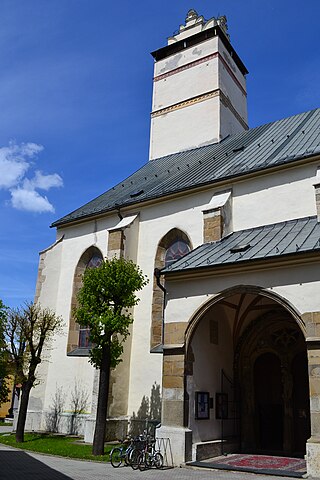
Romanesque architecture is an architectural style of medieval Europe that was predominant in the 11th and 12th centuries. The style eventually developed into the Gothic style with the shape of the arches providing a simple distinction: the Romanesque is characterized by semicircular arches, while the Gothic is marked by the pointed arches. The Romanesque emerged nearly simultaneously in multiple countries ; its examples can be found across the continent, making it the first pan-European architectural style since Imperial Roman architecture. Similarly to Gothic, the name of the style was transferred onto the contemporary Romanesque art.

Cathedrals, collegiate churches, and monastic churches like those of abbeys and priories, often have certain complex structural forms that are found less often in parish churches. They also tend to display a higher level of contemporary architectural style and the work of accomplished craftsmen, and occupy a status both ecclesiastical and social that an ordinary parish church rarely has. Such churches are generally among the finest buildings locally and a source of regional pride. Many are among the world's most renowned works of architecture. These include St Peter's Basilica, Notre-Dame de Paris, Cologne Cathedral, Salisbury Cathedral, Antwerp Cathedral, Prague Cathedral, Lincoln Cathedral, the Basilica of Saint-Denis, Santa Maria Maggiore, the Basilica of San Vitale, St Mark's Basilica, Westminster Abbey, Saint Basil's Cathedral, Antoni Gaudí's incomplete Sagrada Família and the ancient cathedral of Hagia Sophia in Istanbul, now a mosque.

St. Peter's Church is a Lutheran church in Riga, the capital of Latvia, dedicated to Saint Peter. It is a parish church of the Evangelical Lutheran Church of Latvia.

The Basilica of St. Peter and St. Paul is a neo-Gothic church in Vyšehrad fortress in Prague, Czech Republic.

Speyer Cathedral, officially the Imperial Cathedral Basilica of the Assumption and St Stephen, in Latin: Domus sanctae Mariae Spirae in Speyer, Germany, is the seat of the Roman Catholic Bishop of Speyer and is suffragan to the Roman Catholic Archdiocese of Bamberg. The cathedral, which is dedicated to St. Mary, patron saint of Speyer and St. Stephen is generally known as the Kaiserdom zu Speyer. Pope Pius XI raised Speyer Cathedral to the rank of a minor basilica of the Roman Catholic Church in 1925.

Troyes Cathedral is a Catholic church, dedicated to Saint Peter and Saint Paul, located in the town of Troyes in Champagne, France. It is the episcopal seat of the Bishop of Troyes. The cathedral, in the Gothic architectural style, has been a listed monument historique since 1862.

French Gothic architecture is an architectural style which emerged in France in 1140, and was dominant until the mid-16th century. The most notable examples are the great Gothic cathedrals of France, including Notre-Dame Cathedral, Reims Cathedral, Chartres Cathedral, and Amiens Cathedral. Its main characteristics are verticality, or height, and the innovative use of the rib vault and flying buttresses and other architectural innovations to distribute the weight of the stone structures to supports on the outside, allowing unprecedented height and volume. The new techniques also permitted the addition of larger windows, including enormous stained glass windows, which fill the cathedrals with light.

The medieval cathedrals of England, which date from between approximately 1040 and 1540, are a group of twenty-six buildings that constitute a major aspect of the country's artistic heritage and are among the most significant material symbols of Christianity. Though diverse in style, they are united by a common function. As cathedrals, each of these buildings serves as central church for an administrative region and houses the throne of a bishop. Each cathedral also serves as a regional centre and a focus of regional pride and affection.

St. Mary's Church, Rostock, in German Marienkirche, is the biggest of three town churches found in the Hanseatic city of Rostock, in northern Germany. The other two are St. Peter's (Petrikirche) and St. Nicholas (Nikolaikirche). A fourth, St. James' (Jakobikirche), was heavily damaged during the Second World War and subsequently demolished. St. Mary's was designated in 1265 as the main parish church. Since the Protestant Reformation in 1531, it houses a congregation of the Evangelical Lutheran State Church of Mecklenburg.

The Co-Cathedral of Saint Nicholas in Prešov is one of the oldest and most important churches in Slovakia. The external dimensions of the cathedral are 54.7m in length, 34.45m in width. The indoor nave is 16 m tall and tower reaches a height of 71 meters. The temple's design takes inspiration from the Late Gothic hall churches with three naves.

Saint Peter's Church is a Roman Catholic church and minor basilica located in the small German town of Fritzlar. It is often colloquially referred to as a cathedral, due to its great size.

The Saschiz fortified church is a Lutheran fortified church in Saschiz (Keisd), Mureș County, in the Transylvania region of Romania. It was built by the ethnic German Transylvanian Saxon community at a time when the area belonged to the Kingdom of Hungary. Initially Roman Catholic, it became Lutheran following the Reformation. Together with the surrounding village, the church forms part of the villages with fortified churches in Transylvania UNESCO World Heritage Site.

St Joseph's Church is in Skeffington Road, Preston, Lancashire, England. It is an active Roman Catholic church in the Diocese of Lancaster. The church is recorded in the National Heritage List for England as a designated Grade II listed building.

St. Michael's Church in Jircháře, Prague - New Town near the National Theatre, specifically the New Town street, which is called v Jirchářích. It is the seat of Czech, Slovak and English congregation of the Evangelical Church of the Augsburg Confession in the Czech Republic. Its architectural style is not uniform due to alterations in different periods and styles. It is protected as a cultural monument of the Czech Republic.

Basilica of St Giles in Bardejov, Slovakia, is a Gothic sacral building, which is situated in the northern part of the Town-Hall square. Bardejov is located in the larger area of town Prešov in the region called Šariš.

The Basilica minor of the Exaltation of the Holy Cross is a Late Gothic three-nave Catholic church located in the town of Kežmarok in the Spiš region of eastern Slovakia.

St. Castulus church is a Gothic church with Romanesque and Baroque elements. It is located on the Castulus square, in Old town near Convent of Saint Agnes. It is the only church in the Czech Republic consecrated to Saint Castulus.

Gothic cathedrals and churches are religious buildings created in Europe between the mid-12th century and the beginning of the 16th century. The cathedrals are notable particularly for their great height and their extensive use of stained glass to fill the interiors with light. They were the tallest and largest buildings of their time and the most prominent examples of Gothic architecture. The appearance of the Gothic cathedral was not only a revolution in architecture; it also introduced new forms in decoration, sculpture, and art.

The Church of St Mary the Virgin is the main Church of England parish church for the village of Uffculme, Devon, England. First mentioned in a charter dating back to 1136, the present church has a mixture of medieval and Victorian architecture and is a Grade II* listed building. The church building is notable for its rood screen, the longest and oldest in the county, as well as its tall broach spire, a rare feature on churches in Devon.





















